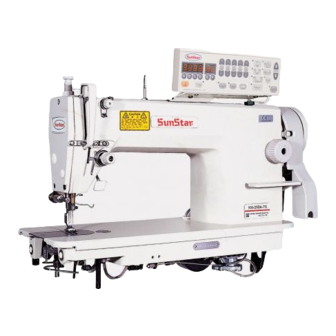Table of Contents
Advertisement
Keystone Sewing Machine Company, Inc.
833 N 2nd Street, Philadelphia, PA 19123 USA
215/922.6900
info@keysew.com
www.keysew.com
USER'S
MANUAL
KM-250/KM-350 Series
High-Speed, 1-Needle, Drop-Feed
Automatic Thread Trimmer
High-Speed, 1-Needle, Drop-Feed,
Needle-Feed Automatic Thread
Trimmer
KM-506/KM-530 Series
High-Speed 1-Needle, Drop-Feed
Knife-Attached Automatic Thread
Trimmer
High-Speed, 1-Needle, Drop-Feed,
Needle-Feed Knife-Attached
Automatic Thread Trimmer
1) For use with maximum ease,
please be sure to read this manual
thoroughly before use.
2) Keep this manual for reference in
case of machine malfunction or
breakdown.
Advertisement
Table of Contents














Need help?
Do you have a question about the KM-250 Series and is the answer not in the manual?
Questions and answers
Реверс не нажимала, но машина шьет назад
If the SunStar KM-250 Series sewing machine is sewing backwards even though the reverse button is not pressed, it may be due to the reverse button being stuck or malfunctioning. According to the manual, pressing the reverse button during forward sewing immediately starts reverse sewing, and pressing it while starting the machine causes it to sew in reverse from the beginning. If the button is stuck in the pressed position, the machine will continue to sew in reverse.
This answer is automatically generated
Merhabalar elimde 250b 7s otomatik makina var makinemde 2 sikinti var birincisi bicagi vurma islemi yapmiyor ikincisi ayagi kalkmiyor bununla ilgili yardimci olabilir misiniz
The manual does not provide specific troubleshooting steps for knife striking operation or the foot not lifting. However, general guidelines include:
1. Knife Striking Issues:
- Ensure the machine is properly assembled and adjusted.
- Check for any obstructions or misalignment in the knife mechanism.
- Use standard OEM parts for repair and follow manufacturer instructions.
2. Foot Not Lifting:
- Verify the automatic knee-lifter settings.
- Adjust the solenoid shaft position to increase or decrease the lifting amount.
- Ensure all components are securely assembled after adjustments.
For detailed troubleshooting, refer to the user manual or authorized service technicians.
This answer is automatically generated